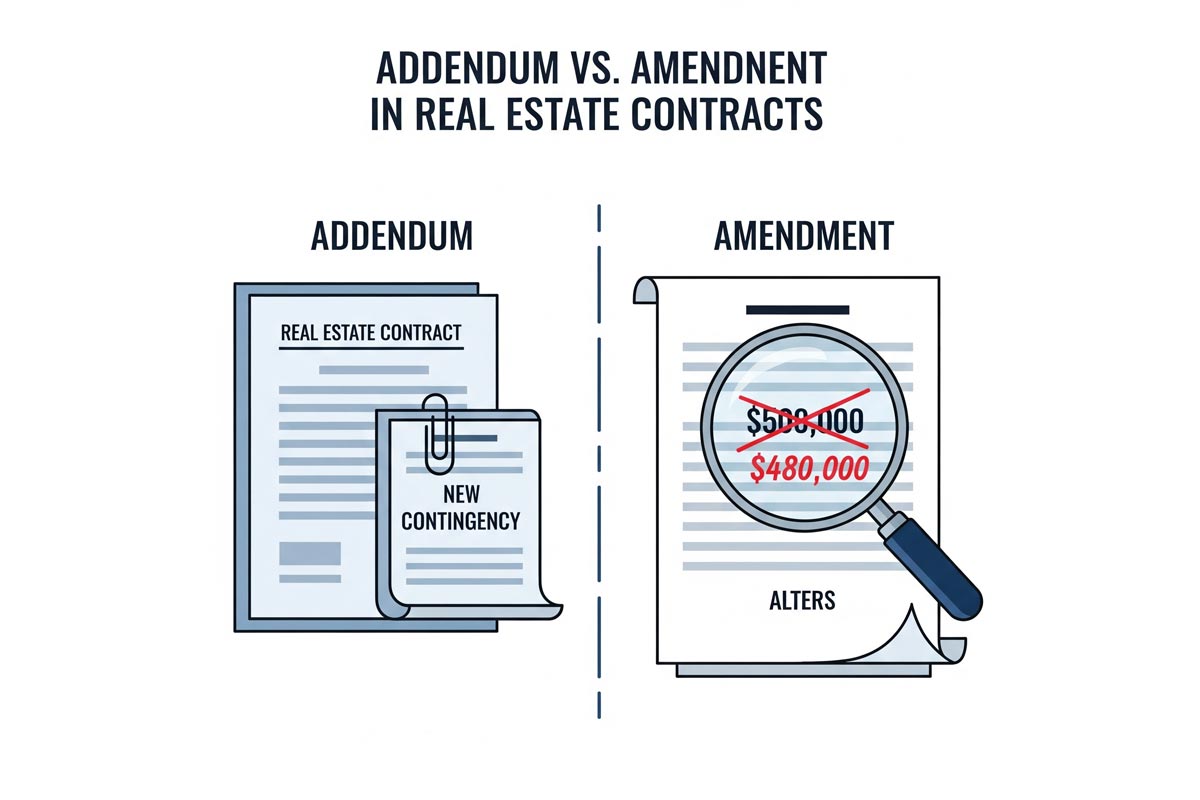
Real‑estate transactions live and die by what is written—and signed—in the contract. Yet nearly every deal, from a starter‑home purchase to a multimillion‑dollar commercial lease, must be tweaked after that first signature. That’s where two deceptively similar tools come in: the addendum and the amendment. Because the terms sound alike, many buyers, sellers, and even new agents mix them up—sometimes with expensive consequences.
This guide cuts through the confusion. You’ll learn the fundamental difference, see practical language examples, spot common pitfalls, and walk away knowing exactly which document to use, when, and why.
| Tool | What It Does | One‑Sentence Analogy |
|---|---|---|
| Addendum | Supplements the contract by adding entirely new terms, conditions, or disclosures without touching existing text. | Like attaching a new appendix to a report. |
| Amendment | Modifies the contract by changing, deleting, or replacing language that is already there. | Like editing a paragraph in the report’s body. |
An addendum (sometimes called a “rider” or “attachment”) is a separate, signed document that becomes part of the original agreement, but nothing in the original contract is struck, deleted, or replaced.
Analogy: You finished your book and later decide to add a bonus chapter—the original chapters stay exactly as written; you just hand readers an extra section.
An amendment rewrites part of the original agreement. You are altering the existing language—price, dates, contingencies, or even simple typos.
Analogy: You catch a typo in Chapter 3 of your book. Instead of adding a new chapter, you open the manuscript and correct that specific sentence.
Below are the most common scenarios you’ll encounter in both residential and commercial deals. For each, notice whether new material is added (addendum) or existing material is changed (amendment).
| Scenario | Example Property Type | “Before” (excerpt) | Addendum Language (conceptual) |
|---|---|---|---|
| New contingency | Rural residence | Contract silent on septic system. | “This agreement is contingent on Buyer’s receipt and approval of a satisfactory septic inspection report on or before August 5.” |
| Personal property inclusion | Suburban home | Contract lists fixtures only. | “Seller shall include the following personal property at no additional cost: LG washer, LG dryer, and GE refrigerator (Model XYZ).” |
| Disclosure attachment | Pre‑1978 home | Contract mentions lead‑based paint but no form attached. | “Lead‑Based Paint Disclosure (EPA‑approved form) is attached hereto as Addendum A and incorporated herein.” |
| Lease pet clause | Apartment lease | Lease prohibits pets. | “Notwithstanding Paragraph 10, Tenant may keep one spayed cat under 15 lbs; Tenant assumes all liability for pet damage.” |
Typical timing: Often drafted with the initial offer or immediately post‑acceptance (e.g., delivery of mandatory disclosures).
| Scenario | Example Property Type | “Original Clause” | Amendment Language (conceptual) |
|---|---|---|---|
| Price change | Residential purchase | “Purchase Price: $500,000.” | “Paragraph 2 is hereby amended to state: ‘Purchase Price: $490,000.’” |
| Closing‑date extension | Vacant land | “Closing Date: July 30 2025.” | “Closing Date is amended to August 15 2025.” |
| Repair credit | Condo | “Seller to repair roof leaks.” | “Seller shall instead credit Buyer $7,500 at closing in lieu of repairs; Paragraph 12 is amended accordingly.” |
| Loan‑type switch | Single‑family home | “Buyer financing: FHA loan.” | “Paragraph 5 is amended to read ‘Conventional 30‑year fixed loan.’” |
| Scrivener’s error | Commercial lease | Suite number misstated as 320. | “Suite number corrected from 320 to 302; all other terms remain unchanged.” |
Typical timing: After the contract is executed when inspections, financing, or negotiations reveal the need to alter agreed‑upon terms.

| Best Practice | Why It Matters |
|---|---|
| Reference the underlying contract by date, parties, and property address at the top of the addendum or amendment. | Prevents arguments over which agreement the change attaches to. |
| Number each addendum/amendment (e.g., “Addendum #1”). | Aids tracking when deal requires multiple modifications. |
| Use clear headings such as “Purchase‑Price Adjustment” or “Inspection Contingency Addendum.” | Improves readability for all parties and attorneys. |
| State the effective date (often the last dated signature). | Clarifies when obligations begin. |
| For amendments, quote the original clause before showing the revised language (or cite the paragraph number). | Reduces ambiguity over what is being altered. |
| Obtain signatures from every party to the contract (and their spouses if required by local law). | An unsigned modification is unenforceable. |
Pro Tip: Keep a running “contract log” noting each modification, date sent, date signed, and current key dates (closing, inspection, loan approval).
While the concepts of addendums and amendments are universal, forms and statutory disclosures vary:
Always consult local forms and professionals to ensure compliance.
Beyond your time in real estate school, understanding the difference between an addendum and an amendment gives you powerful leverage in negotiations and protects you from costly missteps. If you are a buyer, remember that before signing—or sending—either document, consult your real‑estate agent and, for complex or high‑value transactions, a qualified real‑estate attorney. With the right tool and sound advice, you’ll keep your deal on track and your interests safeguarded.
Love,
Kartik
California Real Estate License Delays: How to Pass DRE Education Verification Fast
Holiday Home Sales: A Hidden Opportunity for Agents
What Happens When the DRE Denies Your License (and How to Fight Back)
Out-of-State Agents: Transferring a Real Estate License to California
Understanding DRE Form RE 226: How to Verify Your Experience for a California Broker’s License

Founder, Adhi Schools
Kartik Subramaniam is the Founder and CEO of ADHI Real Estate Schools, a leader in real estate education throughout California. Holding a degree from Cal Poly University, Subramaniam brings a wealth of experience in real estate sales, property management, and investment transactions. He is the author of nine books on real estate and countless real estate articles. With a track record of successfully completing hundreds of real estate transactions, he has equipped countless professionals to thrive in the industry.